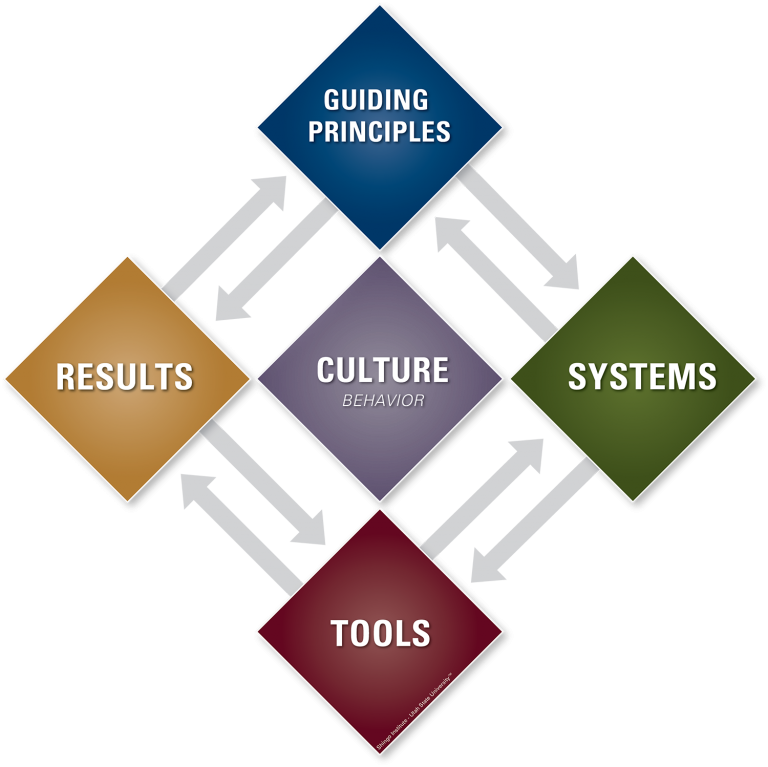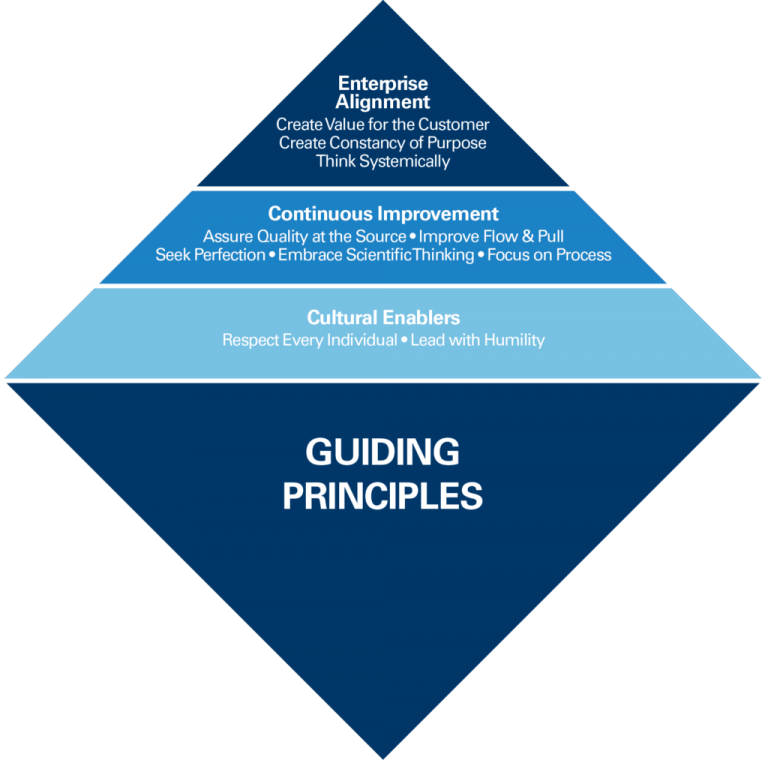Excellence as a management style
To be successful in the long run, any organization must continuously improve. It’s hard work, but the alternative is uncertainty, chaos. There is no third option. The wisdom of leaders and the intelligence and energy of appropriately empowered management and staff are essential to continuous improvement. Also, you need the right culture for success, one in which employees are willing and able to engage in improving their work. Sustainable results also depend on an organization’s culture conforming to certain guiding principles. And in this context, the Shingo Model provides a powerful framework for culture change and ideal outcomes.
Model Shingo
The Shingo model is the result of years of scientific research done by the Shingo Institute. The object of the study is the organizations that once won the Shingo Prize. Research seeks to discover the reasons for the sustainability of success, stagnation and decline of organizations. The Shingo model is the systematic knowledge acquired through these studies. The model reflects patterns and relationships between tools, systems, principles, culture, and outcomes. As observations and research continue unabated, the Shingo Model improves and reflects their conclusions.
The model is not another program or initiative that should be applied in the organization. It formalizes the Shingo Guiding Principles and how they apply to systems, tools, culture, and outcomes. The Shingo model provides a structural understanding for conducting transformation and filling gaps in the work of creating and sustaining a culture of organizational excellence.
Whether the organization’s goals are financial or more altruistic, leaders are focused on results. The design of internal control systems is also carried out with the calculation of ensuring results. The choice of tools is also made to maintain systems and ensure results. And when the result does not meet expectations, the obvious solution for many is to change systems or work tools.
But the existing systems and selected tools, by themselves, do not manage the business and are not able to provide results. People do it. That said, each person has a set of values and beliefs that influence their actions. Ultimately, the cumulative behaviors of people that reflect organizational culture affect outcomes.
Components of the Shingo Model
Guiding Principles
The Ten Guiding Principles of Shingo is the basis for building a strong culture and achieving organizational excellence. They reflect the organization in three ways: culture building, continuous process improvement, and alignment.
Systems
Control systems are a set of tools that work together to achieve a desired result.
Tools
Technologies or methods for solving a particular problem.
Results
Measurable indicators, successful or not, that determine the outcome of systems and individual tools.
Culture
Behavioral patterns of people in the organization (their customs and norms of behavior).

Professor Edgar Schein (Sloan Business School, MTI, USA)
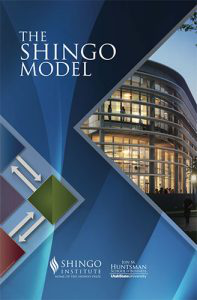
Get a free official Shingo Institute booklet in Russian with a detailed description of the Shingo Model.
Culture left unattended can lead to serious negative consequences. For example, the norm may be to solve problems in an emergency and to encourage “firefighters” to eliminate the consequences, but not the causes. But by looking for the culprits rather than the causes for every failure, concealment of possible or existing problems is encouraged. Also, by not giving sufficient authority and means, lack of initiative, acting under orders, and total rejection of personal responsibility are encouraged. Constant reports to the top, but not solving problems on the spot immediately and collectively, destroys trust between people and teams in the organization and creates an atmosphere of fear, survival and backbiting.
Conversely, a culture in which trust is the main value, and the norm is respect for everyone, initiative and innovation, delegation of authority and teamwork, promotes very different ways of overcoming difficulties in the work. Accordingly, we can expect different results.
After researching management systems for more than 30 years, Shingo Institute experts found…
Three patterns of organizational excellence - Shingo Insights
That is, the ideal result can only be achieved by acting perfectly in each case. Making ideal patterns of behavior obvious to everyone in the organization is the task of leaders. More perfect acts make for a closer perfect outcome.
It is clear that beliefs have a determining influence on actions. However, do not discount the control systems. Most of the existing management systems were created to achieve results, but without regard to their impact on human behavior. In such cases, it will take a lot of effort for managers to change them in order to get them to do the perfect thing with them.
Stephen Covey defined the term “principle” as some universal natural law that is timeless in its meaning and quite obvious. He said that a person’s values influence his actions, and the principles he adheres to determine the consequences of his actions. The better a person understands the principles, the more ideal his actions are. For example, the clearer it is to the manager what behavior people need to achieve, the better his management system and tools are; and consequently, the closer the ideal results are.
In order for every organization to succeed and hold the bar, it must continually improve and involve everyone in the process. Failure to do so inevitably leads to the decline of the organization. This is also true for any human being. Even though we know that perfection is an unattainable ideal, striving for it brings out the best in us.
Guiding Principles

Stephen P. Covey, bestselling author of The Seven Habits of Highly Effective People
The Guiding Principles are 10 fundamental rules that lead to a sustainable organizational culture of operational excellence. Crystal Guiding Principles looks at the organization in three ways.
- Cultural Enablers – principles of cultural formation;
- Continuous Improvement – principles of operational improvement;
- Enterprise Alignment. – The principles of organizational coordination.
The first step to changing a culture is to understand the meaning of each of the 10 principles. Leaders cannot develop and manage a culture until the meaning of each principle is clear to them. Understanding and adopting the principles entails a fundamental change in the policy of creating a culture of continuous improvement.
At the very least, it will require curiosity and experimentation on the part of the leader. In order for a person to change his beliefs he must have proven experience; and experience is deeds. The leader, armed with principles, must predetermine actions so that people will have the right experience.
The Principles of a Healthy Culture (Cultural Enablers)
Fundamental principles in the Shingo Model that influence the formation of a productive culture in an organization. They refer to people and their relationships.
Respect everyone's individuality
It is not difficult to understand this principle. Just asking yourself “why?” The answer is simple – we are all human. We are equal in our potential and opportunities. Because it is an undeniable fact, every personality deserves respect. Feeling it, people are willing to give much more than their allotted hours to work; they give it their mind and heart.
Manage on the basis of equality
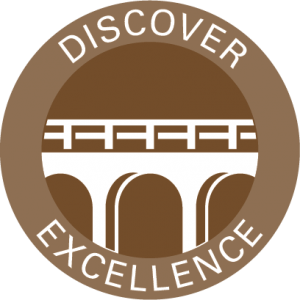
workshop
Principles of Continuous Improvement
If the first two principles referred to people, then the following ones refer to the processes within the organization that are created and implemented by people. That said, quality, performance and cost are not the only metrics to evaluate. In addition, value from the customer’s point of view must be considered: the ease and speed of internal information exchange, product innovation, flexibility and fast delivery, the impact on the environment and society as a whole.
Strive for perfection in everything you do
Perfection is an ideal that is hardly attainable. But striving for it creates an environment for continuous improvement. The limits of our possibilities, are determined only by the paradigms through which we perceive current reality. Paradigms change, perceptions of what is possible change, reality changes.
Practice the scientific approach
Focus on processes
The results are a consequence of the processes. Even experienced professionals cannot achieve perfect results with poorly coordinated processes. Many people tend to look for someone to blame when things go wrong. But in reality, the causes should be looked for in the processes, not in the people.
Ensure quality at the source
Excellent quality is only possible when every part of the job is done right the first time. If not, find the cause and fix it without delay.
Improve flow and pulling
The value of a product is highest when it meets real demand and is created in a continuous flow. Organize production as a continuous flow and let customer controversy “pull” products from it. Don’t produce more than your customers demand. Eliminate losses – everything breaks the continuity of the value stream.
Principles of Enterprise Alignment
The principles of coordination are aimed at achieving the goal of the organization. The direction of effort of each element of the organizational system must be aligned with the strategic goal. Only then can it be achieved.
Think systemically
Ensure consistency of the organization's mission and purpose
The clarity of what the organization exists for, where it is going and how it will get there, allows each member to assess their actions for compliance with the mission and purpose, to make meaningful changes in processes, to understand responsibilities and risks.
Create value for the consumer
Ultimately, the value of any effort should be viewed in terms of value to the consumer – what they want and what they are willing to pay for. The position of the organization that wastes time and resources useless for its customers is not sustainable in the long run.
A new management paradigm
Operational excellence is the mindset that organizations use to continuously change for the better. Real change is only possible when leaders understand the impact of principles on operational performance. The job of leaders is to put guiding principles into the organizational culture. The managers’ job is to build and maintain management systems around them. But the participation of each member of the organization in the improvement of activities is the key to success and confident progress toward the goal.
Conducting research on management systems for more than 30 years, the experts of the Shingo Institute, formalized their results in the Shingo Model. The idea of the Shingo Model is that culture in an organization is a determinant of viability, leading to success and competitiveness, or to degradation and decline.
The Shingo model reveals the systemic relationships within an organization, taking culture out of the realm of givenness and making it a means to an end. Leaders and management can and should influence it consciously, and the Shingo Model provides them with all the knowledge they need to do so. The Shingo model is a concept for building a viable organization. Its purpose – to form a leader’s way of thinking, to teach how to systematically transform and develop the business to achieve the target results. Whether an organization qualifies for the Shingo Prize or not, its true prize will be a sustained culture of organizational excellence.
About the Shingo Institute
Purpose of the Shingo Institute
Using immutable principles, help organizations build a healthy culture for operational excellence.
Mission of the Shingo Institute
Improve tools for improvement by researching, teaching and providing expertise, providing recognition to organizations striving to achieve world-class sustainable results.
History of the Shingo Institute
Not as many people have made tangible contributions to the development of TQM, JIT, and Lean Manufacturing as Dr. Shigeo Shingo.
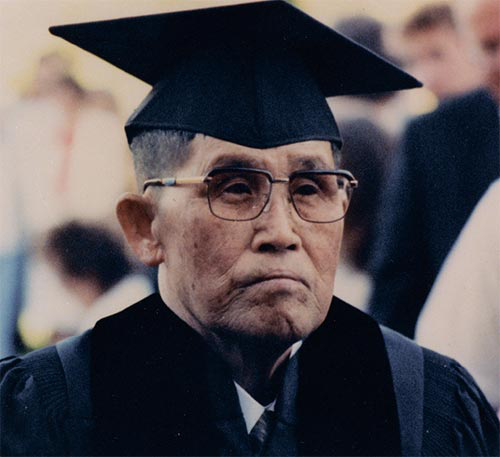
Years before the popularity of these ideas in the West, Shingo wrote about the need for quality assurance at source, customer value, zero-stock production and quick changeover of equipment (SMED). He taught that there is no better place to solve problems than where they manifest themselves (going to gemba). During his life he published 18 books and many articles. Seven books have been translated from Japanese into English. He worked closely with Toyota management, especially Taiichi Ono, to implement these cutting-edge ideas.
Having been at the forefront of new ideas in production management, Shingo looked forward to working with an organization that would continue his life’s work and popularize them. In 1988, Shingo received an honorary doctorate in management from the University of Utah. Later, his ambitions were realized: the Shingo Prize was established and the Shingo Institute was organized. The Shingo Award has become internationally renowned and was awarded for excellence in operational excellence.
In 2000, the influential magazine BusinessWeek dubbed it the “Nobel Prize in manufacturing. The Shingo Institute explores the experience of transformation to lean manufacturing and has developed management education programs that have become successful worldwide and are available through a network of affiliate representatives.
The Shingo Prize has been awarded in different years to companies such as:

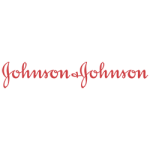

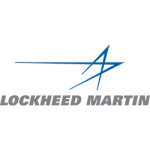
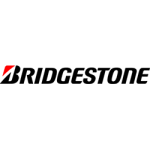




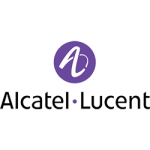
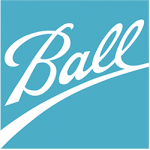

For a complete list of Shingo Prize-winning companies, visit this link: https://shingo.org/awards/
Members of the Shingo Academy support the mission of the Institute in every way possible. These are people who have been honored for significant service in the field of operational excellence. Among the big names are Jace Womack, John Shook, Massaki Imai, Jeff Liker, Stephen Covey, as well as presidents of global manufacturing companies and high-ranking officials. A complete list of full members of the Academy can be found at this link: https://shingo.org/about-the-shingo-institute/shingo-academy/

Discover Excellence

